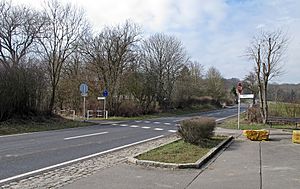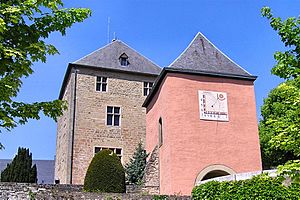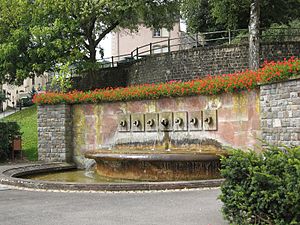Luxembourg (district) facts for kids
Quick facts for kids Luxembourg |
|
| District | |
| Country | |
|---|---|
| Capital | Luxembourg |
| - coordinates | 49°36′36″N 6°08′00″E / 49.61000°N 6.13333°E |
| Area | 904.34 km² (349 sq mi) |
| Population | 401,041 (2014) |
| Density | 443 /km² (1,147 /sq mi) |
| District | 24 February 1843 |
| Subdivisions | 4 cantons 46 communes |
| Timezone | CET (UTC+1) |
| - summer (DST) | CEST (UTC+2) |
| ISO 3166-2 | LU-L |
The District of Luxembourg (which is Lëtzebuerg in the local language) was one of three main areas in the Grand Duchy of Luxembourg. Its main city and capital was Luxembourg City.
In 2015, these districts were officially ended.
This district was located in the southwest part of Luxembourg. It was the second largest district, covering about 904.34 square kilometers. It was also the most populated district. In 2014, about 401,041 people lived there. This meant it had a population density of about 443.5 people per square kilometer.
Contents
History of the Luxembourg District
The districts of Luxembourg were created on 24 February 1843. The District of Luxembourg was one of the first three districts in the country.
Over time, some changes happened.
- On 30 May 1857, the Mersch canton was taken from the Luxembourg district. It became part of a new district called Mersch.
- However, on 4 May 1867, the new Mersch district was ended. The Mersch canton then rejoined the Luxembourg district.
- In 2012, two smaller towns, Bascharage and Clemency, joined together. They formed a new, larger town called Käerjeng. This change meant the total number of towns (communes) in the district went from 47 to 46.
Geography of the Luxembourg District
The District of Luxembourg was surrounded by different areas.
- To the north, it bordered the Diekirch district.
- To the east, it bordered the Grevenmacher district.
- To the south, it shared a border with France. Specifically, it touched the French areas of Meurthe-et-Moselle and Moselle.
- To the west, it bordered Belgium. This was the Luxembourg province of Belgium.
How the District Was Organized
The Luxembourg district was divided into smaller parts. It had 4 larger areas called cantons and 46 smaller towns called communes.
| Canton | Capital | Area (km²) |
Population (2014) |
Density (inhab./km²) |
Communes | |
|---|---|---|---|---|---|---|
| 1 | Capellen | Capellen | 199.21 | 43,607 | 218.9 | 10 |
| 2 | Esch-sur-Alzette | Esch-sur-Alzette | 242.77 | 160,960 | 663.0 | 14 |
| 3 | Luxembourg | Luxembourg | 238.46 | 167,199 | 701.2 | 11 |
| 3 | Mersch | Mersch | 223.90 | 29,275 | 130.8 | 11 |
Cantons and Their Communes
Here are the cantons and the towns (communes) that were part of each:




See also
 In Spanish: Distrito de Luxemburgo para niños
In Spanish: Distrito de Luxemburgo para niños

